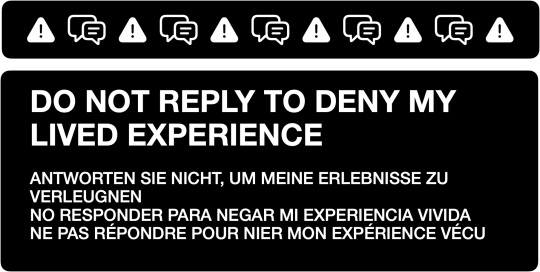Text
Minimal group paradigm
Psychological theories which attempt to explain the origins of prejudice fall into two major categories. Personality theories, which see the source of prejudice as being in the individual and social psychological theories, which see prejudice as a result of group membership.
An example of a personality theory would be Bandura's social learning theory, which argues that attitudes such as prejudices are learned from role models.
Many social psychological theories argue that society may be much more important than personality types in accounting for prejudice. Such theories see prejudice as a result of group membership and group interaction.
[…]
Tajfel like Sherif believes that the personality approach is inadequate in explaining prejudice and he also uses a social psychological approach. However, Tajfel et al (1971) argue that 'competition' is not a sufficient condition for inter-group conflict and hostility. Tajfel does not deny the importance of 'competition' between groups, personality types as explanations for the origins of prejudice but argues that mere perception of the existence of another group can itself produce discrimination. Tajfel et al argue that, before any discrimination can occur, people must be categorized as members of an in-group or an out-group, but more significantly the very act of categorization by itself produces conflict and discrimination.
By in-group we mean a group to which a person belongs, or thinks he or she belongs.
By out-group we mean a group to which a person does not belong, or thinks he or she does not belong.
[…]
Results/Findings
The experiments carried out by Tajfel clearly demonstrate that inter-group discrimination is easy to trigger off. Tajfel demonstrates that the very act of categorization into groups is enough to produce conflict and discrimination.
In making their intergroup choices a large majority of the subjects, in all groups in both conditions, gave more money to members of their own group than to members of the other group. Intergroup discrimination was the strategy used in making intergroup choices.
In contrast the in-group and out-group choices were closely distributed around the point of fairness.
The second experiment also clearly demonstrated that the most important factor in making their choices was maximizing the differences between the two groups.
------
I think about this one a lot. (I also see the psychology vs sociology thing as a "yes and".)
(original text from here but it's an old website without a secure link)
If everything above this line was tldr, see also @myjetpack:

23 notes
·
View notes
Text
Myth is not entertainment, but rather the crystallisation of experience, and, far from being escapist, fantasy is an intensification of reality
Alan Garner
0 notes
Text
A more accessible version of the recent movie. Something for the whole family to enjoy.

2 notes
·
View notes
Text
Saved from oblivion!! Praise be to internet archivism

Immensely powerful thrift shop find, google drive to follow
99K notes
·
View notes
Text
My personal utopia would be more lecture content on tumblr feeds
Utopian Realism, a speech by Bruce Sterling
*I never posted any lecture of mine on Tumblr, even though Tumblr would seem to have plenty of elbow-room for hour-long, learned, European public lectures (with many lecture slides).
*Might as well give that a try and see what happens.
From the Technology Biennial in Turin, Italy, April 02024.

Thanks for coming to see me. As Loredana Lipperini just pointed out, I am Bruce Sterling, here to deliver my speech on the theme of “realistic Utopia” — the public Utopia, and the private Utopia.
This first slide would be the hero of my remarks today, because he’s the world’s biggest expert on Utopia. He’s called “Raphael Hythlodaeus.” In the Italian editions of the book “Utopia,” he’s “Raffaello Itlodeo.”
Here’s a picture of Raffaello personally meeting Sir Thomas More, and Sir Thomas More’s friend and host, Peter Gillis, in the year 1515.

The book was published 500 years ago in the Latin language. The author was Sir Thomas More — but Thomas More was a lawyer. He didn’t plan to be a novelist. In the book, he claims that he’s simply writing down the testimony of Raphael Hythlodaeus. The source for the book is allegedly Raphael (according to Thomas).
So, the novel “Utopia” was a kind of a hoax or a joke that Thomas More invented — while he was on vacation.
This book project happened because More had to leave England on official business. He had to leave his private home, and his beloved family, and take part in public life, as a diplomat in the service of the king of England. So, Thomas More had to travel, and go meet some Spanish officials in the city of Bruges on the European continent. So he left England, and he dutifully journeyed to Bruges. But — after some weeks of diplomatic struggle — he realized that the negotiations were going nowhere. His negotiations were a hoax and a joke, because the king of England and the king of Spain were quarreling. They had no intention of ever reaching an agreement.
So Thomas More had to spend six long months of his life in Europe pretending to be a diplomat and a lawyer, to satisfy reasons of state. He could not achieve anything useful or practical on that mission.
So, More was a bit upset by this situation. He left the city of Bruges, where nothing was happening. He went to Antwerp instead, because he had a friend there. His friend was a fellow scholar named Peter Gillis. Peter Gillis was an Antwerp city official. He was in government, and he was quite well-to-do, a very well-connected guy. So, he could play host to Sir Thomas More. Thomas More was welcome to stay in his private house for no money, and to eat the family’s food at no charge, and just relax as an honored house guest, for several months.
So, Thomas More and Peter Gillis are in this private home, avoiding actual work. They enjoy many free-wheeling, private, intellectual discussions, which are all about law, and justice, and business, and economics, and politics, and the general state of the world.
These two intellectuals agree that the state of the world is pretty terrible. Clearly the real world is quite bad, it’s not a Utopia at all. In fact the first part of the book “Utopia” is pretty much all dystopia. It’s about how bad things are in Europe, and it’s rather realistic too — these are grim assessments.
So, Thomas More and Peter Gillis, while discussing the world together, decide to invent this wandering scholar named Raphael Hythlodaeus. The wise and learned Raphael can speak Latin and Greek, just like they do — but Raphael has been to a country where everything works.
Peter Gillis even invents a Utopian alphabet, and he writes some poetry in the language of Utopia — just to demonstrate that he can play this fun Utopian game with his guest Thomas More.

Peter Gillis is willing to cooperate. He even pretends to personally introduce Thomas More to Raphael Hythlodaeus.
In the book, Raphael appears, and he starts talking. He recites the entire story of Utopia. Raphael speaks the book “Utopia,” aloud. It’s 30,000 words of text, so Raphael recites this book in one long afternoon. It’s a three and a half hour lecture, and Thomas More writes it all down.
However, it’s somehow not boring. It’s a brilliant, world-class lecture, because Raphael Hythlodaeus is quite an amazing guy. Raphael doesn’t look rich or famous. Basically, he looks like a sailor. He’s got a long beard, and he’s kind of weatherbeaten. He’s a long-haired wanderer in beat-up old clothes.
He says that he’s from Portugal — he’s a native of Portugal — but somehow he’s been to Persia, and Ceylon, and spent rather a lot of time in Belgium. He’s been to Brazil. He knows England very well. Raphael Hythlodaeus knows the Archbishop of Canterbury personally.
If you read the book carefully, it turns out that Raphael Hythlodaeus left Portugal — he went to Brazil to explore the new world — and he crossed South America, somehow. Then Raphael crossed the Pacific Ocean, discovering several new countries that nobody else ever heard of. Somehow, after visiting Ceylon, he returned back to Portugal.
So Raphael Hythlodaeus has circled the entire world — several years before Ferdinand Magellan and his fleet tried to do the same thing. Raphael is the first guy to ever travel around the world.
Why?
Why did he do it?
Well, basically, it’s because he’s a tourist.
He derives no political or economic benefit from all this wandering. He just wanders — he tours. He says that he had a lot of money once, but he gave all the money away — to members of his family, and to friends. He refuses to ever serve in any government. He understands law. He understands economics. He’s a super knowledgeable guy. But he never takes part in public politics, because he says that it’s slavery. There’s no reason for him to stop travelling and ever do that work.
Raphael Hythlodaeus is basically a dropout hippie backpacker. He’s a refusenik. He despises power. He despises wealth. He’s rigorously anti-materialistic. He’s an intellectual dissident.
He’s not a pilgrim of any religious faction. He doesn’t engage in any trade while he travels. He has no career. He’s not a lawyer. He’s not a banker. He’s not a patriot — he’s never going back to Portugal. He cut his ties with the homeland. He’s cosmopolitan.
Any town in the world is good enough for him. Antwerp is just fine. He’s happy to be in Antwerp, although he has no reason to be there. He’s just in Antwerp while talking to Sir Thomas More. He has no wife. He has no mistress. He has no children, no grandchildren. He has no duties. He never has to change clothes.
Every day — he says — he just does whatever he likes.
He just does whatever he likes!
Raphael Hythlodaeus is the most utopian figure in the book “Utopia.” He’s a one-man Utopia. He’s a personal Utopia — because he makes a utopia all by himself, just for himself.
This struggle between the private, personal Utopia, and the political, public Utopia, is present from the beginning of the book “Utopia.”
In the book, Raphael says that he lived with the Utopians for five years. He knows everything there is to know about them. He studied them very closely. He knows the Utopian language, he knows their alphabet, their history, their military, their judiciary, their economic system, their justice system. He knows how they educate the youth. How they raise crops, what they eat, how they dress, the transportation system. Everything.
He just comprehensively knows everything about that society — every driving force that matters, every aspect that makes a country a country.
So Thomas More and Peter Gillis, they make lunch for him. They just invite this world traveller over to the private house they share. They offer him something to eat.
After they eat together, Raphael is quite happy to tell them everything there is to know about the Utopian system. For no pay — no reward. He doesn’t want any credit in the book, either. He just delivers Utopia to them, in one comprehensive talk.
Then Raphael Hythlodaeus just disappears. He has complete existential freedom. He just drifts around the planet like the wind. He’s a Utopian tourist. He’s a traveling one-man show. He’s like an exile on planet Earth.
He’s a fictional character and the book “Utopia” is a fictional book, but Thomas More was a very real person. More was inventing this Utopia game, and making it up in detail, mostly to amuse his host Peter Gillis, who was feeding him, and sheltering him.
But Thomas More ran out of vacation time. He was on vacation in Antwerp, but he had to go back to England. He had to return to his private house, and to resume his public career as a working lawyer.
He had no more time ever to write any fiction. Thomas More never wrote fiction again. He wrote a lot of government tracts. He wrote sermons and legal opinions. No more fiction, though.
After about a year in England, More bundled up all his Utopia papers. He put the game aside, and he sent all the paperwork to Peter Gillis. He said: you know, Peter, I have no leisure time to mess with this game anymore. Why don’t you see if you can do something with it? You participated, so just do anything you want with this Utopia project. Maybe Erasmus can help you.
That would be Desiderio Erasmus of Rotterdam, the very famous European scholar. Erasmus did help — he helped Peter Gillis, and together they published the world’s first edition of Utopia.
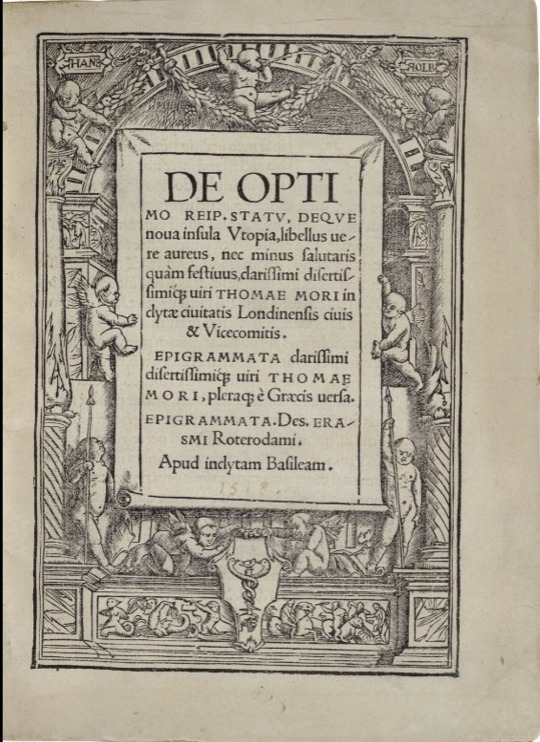
That’s the book. You can see that Erasmus is the editor. Erasmus has added plenty of his own witty epigrams to the text. Erasmus knows this book is innovative and strange, and he’s trying to increase sales by including some Erasmus content.
The book was a private joke for Thomas More — because it was only published in Europe. This is him, by the way.

This is the author of Utopia, when he had achieved high rank in the English government. Thomas More doesn’t care about novelists — there was no such profession, there were no copyrights. He’s an intellectual scholar who became a public politician. He works for the English government — the royal court in London. He’s prosperous. He builds a grand private mansion for himself and his family. This is the house:
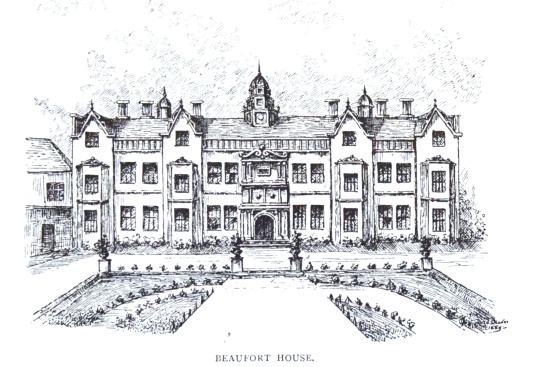
His book Utopia is not published in England — not while More was alive. The English knew practically nothing about this novel, written in Latin, in Europe, by their Lord Chancellor, rather discreetly.
Here’s Thomas More in his private life.
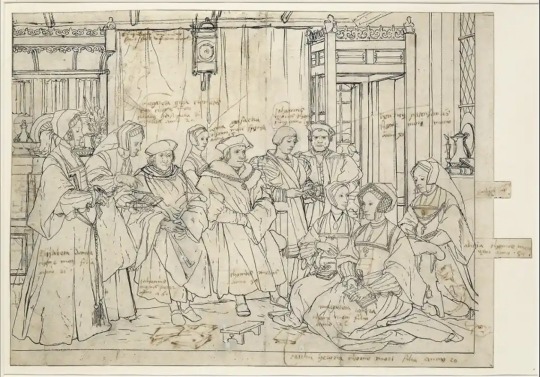
This a sketch of a portrait that he’s working on, together with a hired artist. More has a gold chain around his neck because he’s become the Chancellor of England. However, his private family life is of great concern to him. Thomas More is writing many careful hand notes on this sketch, so that the artist can paint it properly.
This is a portrait of Thomas More’s entire household. Not just himself — all his relatives, and also his household retainers, everyone under his roof. They’re all gathered in his house, to be recorded for posterity.
It’s really quite a nice private house. It’s got a very high-tech clock on the wall. If you look at it: flower bouquets, vases, curtains….
All the women in this portrait have books. Because they’re all literate. Thomas More has educated every woman in his house. They understand Latin. They can write Greek. They know astronomy, music, mathematics. They’re some of the most highly educated women in the world. He educated them privately. Inside the house. Women could not go to school, but he pulled in the best scholars and he had them give lessons to his wife and his daughters. And retainers. And anybody who’s listening.
More’s private house is a kind of Utopian University.
This is the eventual painting which was made from the sketch.

The fellow in red, that’s Thomas More’s father.
Dad was also a lawyer, and he was also involved in politics. But, he got involved in a serious controversy. He was imprisoned in the Tower of London.
That was dad’s experience. He had to go inside the Tower of London for a month. A terrible place. A dungeon. Political opponents of the English regime, they’re tortured and sometimes murdered in the Tower of London. A very sinister place.
One month of that Tower of London prison experience was plenty for dad. He retired from public life immediately. He never sought political power again. He just went back to the house with Thomas More and the very educated girls. There was plenty to do in there. It’s a private house, but look at it, it’s nice. There are carpets. Dogs. Nice clothes. They have some messengers, like a scholar in the back, writing some mail. It’s so civilized that it’s like a different world.
Things go well for a while — but then the author of “Utopia” himself gets into some very serious and realistic political trouble. Because the king of England is divorcing his wife, who is a Spanish princess. He’s removing the Kingdom on England from the Catholic church. It’s basically a Brexit situation.
He’s seceding from Christendom, and declaring himself the spiritual head of the Church of England.
Thomas More does not approve of this. He’s very pro-European, he’s a diplomat. He knows the idea is terrible. There will be nothing but trouble from it.
He tries to be diplomatic with the King. He gets into all kinds of legal arguments. This is no use. King Henry the Eighth, he’s determined to marry six different women. It’s realpolitik. It’s a political crisis. The king will not back down. More leaves power, he tries to escape the dismal mess and go on vacation. He just goes back to his private house. Like his dad.
I’m not in the government, he declares. I want nothing to do with government. I don’t seek power. I don’t want wealth.
But his private life cannot protect him. The regime insists that he has to sign a public declaration that the King has moral authority over the Pope. He’s just required to sign this — to collaborate. He refuses. It’s a very long, painful controversy. He doesn’t want to sign. He’s fighting on ethical principle. I’m a private citizen. I’m in my own house. I want nothing to do with politics. You can’t make me sign public documents against my will.
That struggle doesn’t end well. Here is a painting of the author of Utopia getting arrested for treason against the state.
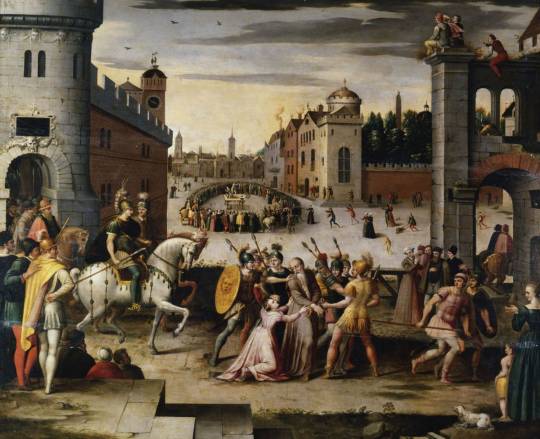
In the foreground of the painting, his daughter is clinging to him. Don’t take Dad from our house! Then in the background of the painting, Thomas More is getting publicly executed. His head is chopped off with an axe on a block.
The details here are interesting. The realism of what really happened to this utopian author. They cut his head off his body in public.
Then, one of the daughters managed to collect his body. She didn’t get the head. The head was boiled in a pot, in order to preserve it. Then it was painted with tar. His head was painted with pitch as a kind of preservative.
Then the head of the author of “Utopia” got stuck on a long spike on the London Bridge.
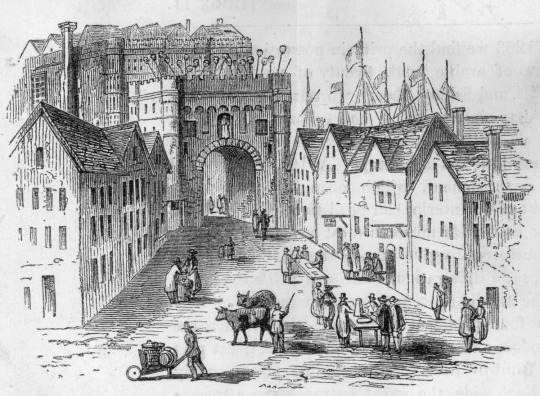
This was customary justice in England at the time. This definitely happened to Thomas More. In historical fact, his head was placed on one of those spikes on the top of the arched bridge, in much the same way that you can see here in this everyday London woodcut.
After a month of public exposure, of the author’s head on a spike, the legend says that one of his other daughters somehow managed to collect his head. Somehow, she retrieved the head off the spike, even though the boiled, tarred head was supposed to be thrown into the river Thames. That was the custom with the heads of traitors.
She had no house, because her father was a traitor and the house had been confiscated. So she’s homeless, but she’s clever and well educated. She speaks Greek, speaks Latin, she understands astronomy, music, mathematics. She’s a cosmopolitan woman from a private house, and somehow she manages to persuade the “Keeper of the Heads” to convey her father’s severed head.
She carries it away from the public shame of the London Bridge. It’s not clear what happened to the head. There are a number of various stories about what she did with it afterwards.
To my mind, this is the ultimate “realist utopian” image. If somebody says the word “Utopia” to you, you should think of an adult woman smuggling the severed head of her father away from an execution.
That’s what it’s like. You write “Utopia” and your grieving daughter somehow steals your chopped-off head, and smuggles your head away in a bag.
Now we forget about Thomas More for the rest of the presentation — because he’s dead. Meanwhile, there’s Italy. Yes, Italy!
In Italy, nobody much cares about More’s head being cut off, but they are reading his book “Utopia.” Because Italians — it turns out they love Utopia. The book’s editor, Erasmus, is very popular in Italy — the University of Torino gives Erasmus a degree in theology. So Italians eagerly read Thomas More’s book in Latin, and they understand that this is speculative political fiction. It’s quite an interesting thing to do.
There’s even a kind of fantascienza genre of utopian writing — not in England, but in Italy.
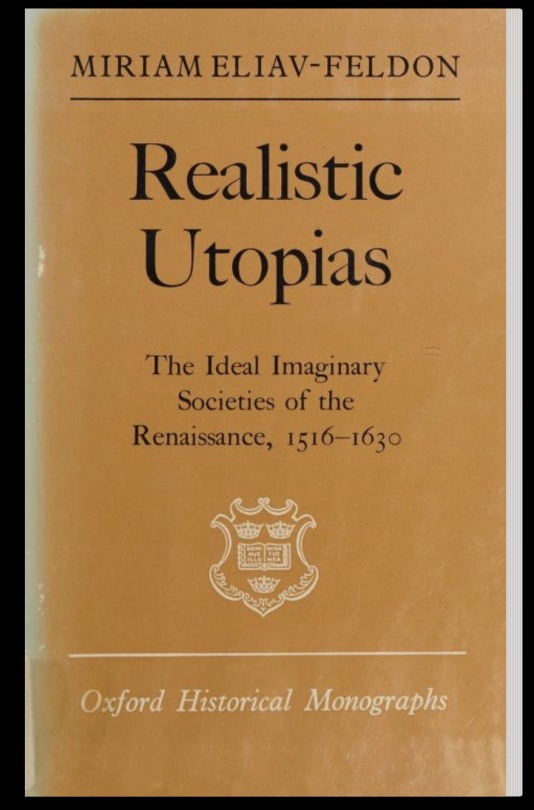
There’s a whole set of utopias written by various authors.
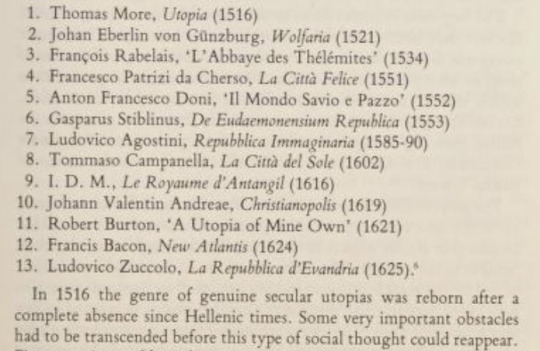
Most of those authors aren’t English — English people know your head comes off, you don’t want to mess with it — but there are all these other guys writing Utopias.
There’s Tommaso Campanella — his book is still in print. You could go buy it today. It’s kind of interesting.
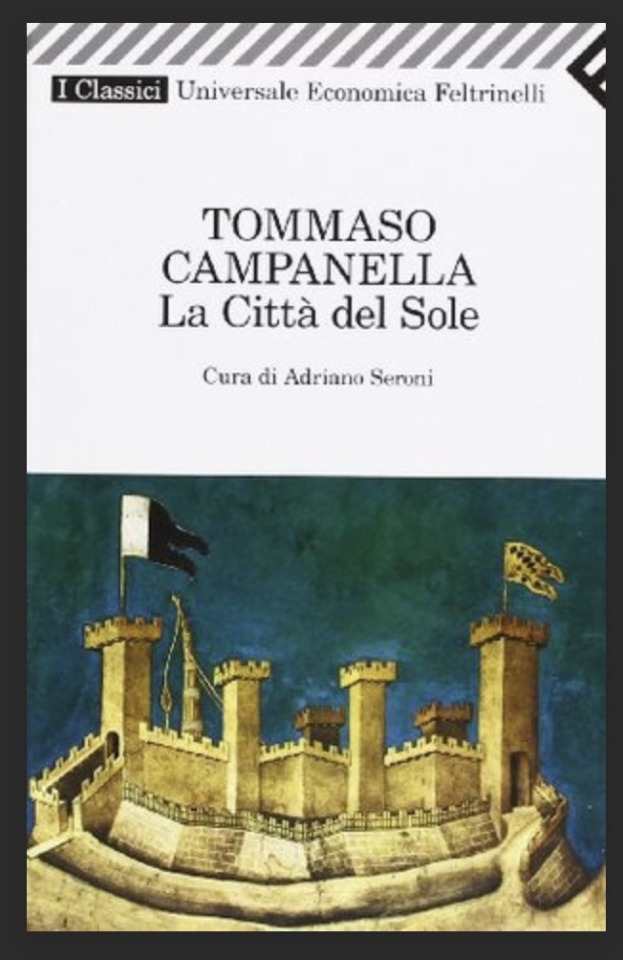
There’s Ludovivo Agostini. He still has some interest to scholars. The Imaginary Republic.
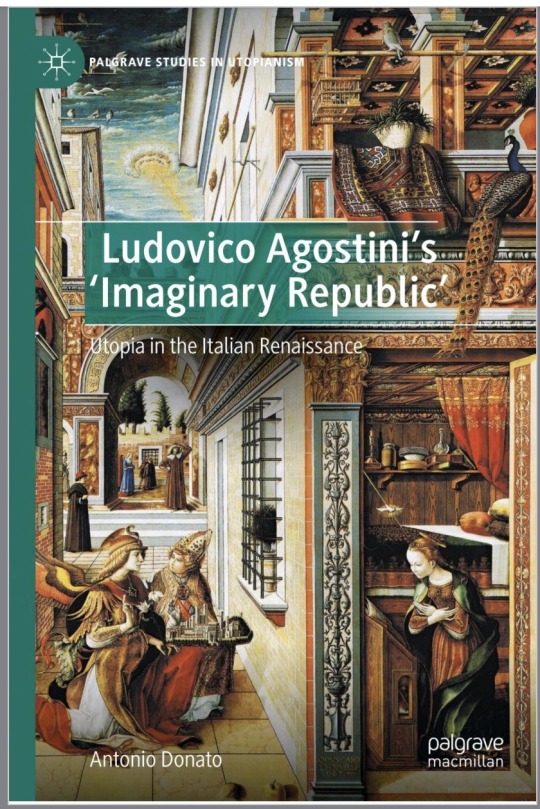
What a good idea.
This is Anton Francesco Doni.
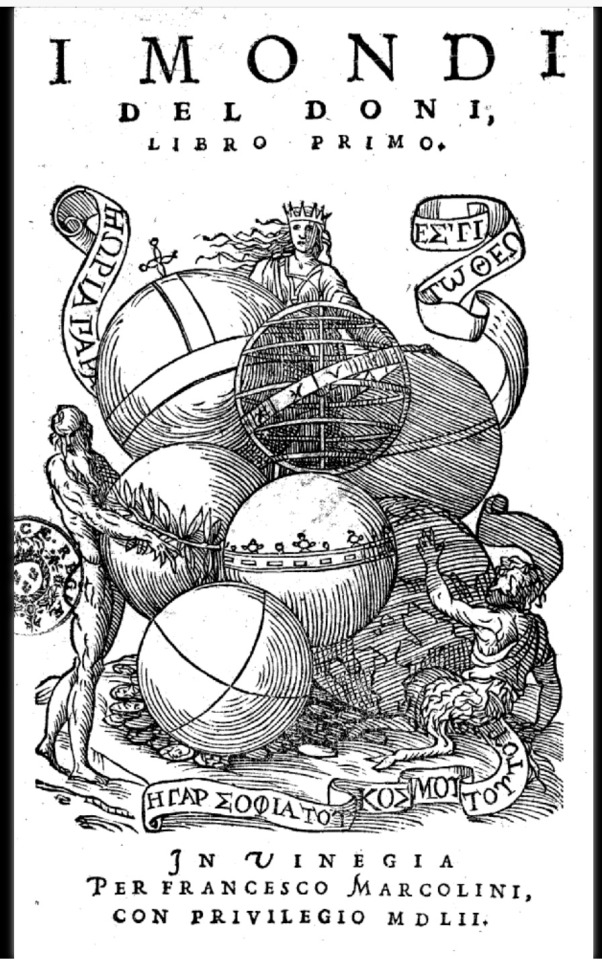
He’s probably the weirdest author of historic Utopias.
He wrote one that’s rather like science fiction, a weird book meant to be funny and entertaining. Doni’s quite an odd character.

Here’s an Italian political anthology where many Italian political writers are describing the real politics of real places. In the end, they just throw in Thomas More’s Utopia. Why not? Does it even matter if it’s an ‘imaginary country’? It’s about the principles of understanding countries. How do you describe them? How do you explain how they work?
That’s what matters about utopias. That’s the realistic reason to do it.
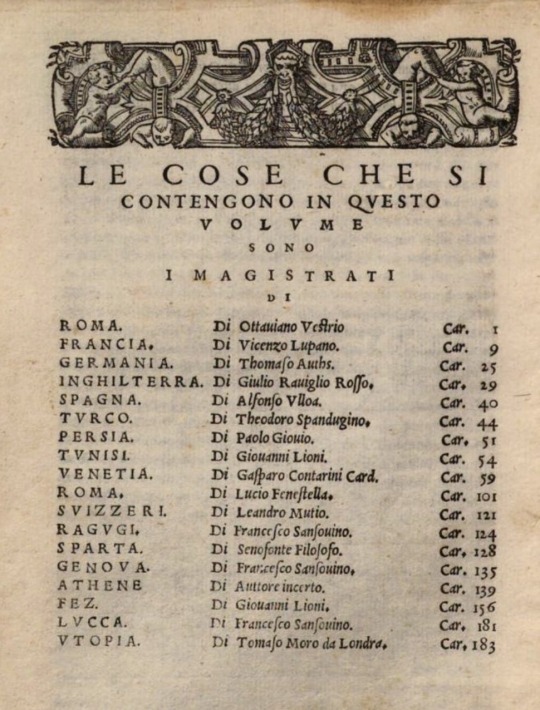
Now we come to a realist political writer who understands Thomas More. He likes to quote Thomas More. He’s Catholic like Thomas More. He’s a Latin scholar — although he writes in Italian.
Unlike Thomas More, he’s extremely realistic. This is Giovanni Botero.
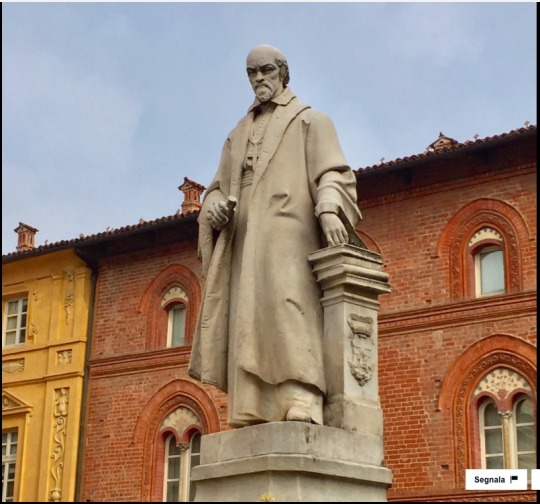
Or, rather, a well-deserved statue of him. Botero wrote a book which was a utopian manifesto, but for the city of Torino.
Yes, Torino was a planned project with a political theory. Here’s his street here in town — it’s over in the Quadrilatero — the oldest part of the city. The “Via Giovanni Botero.”
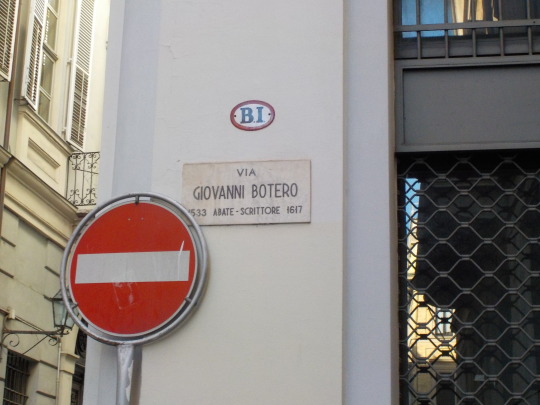
Here’s his book, which is all about politics, and it has an afterword. It’s a political book about government, including a work of analysis about cities.
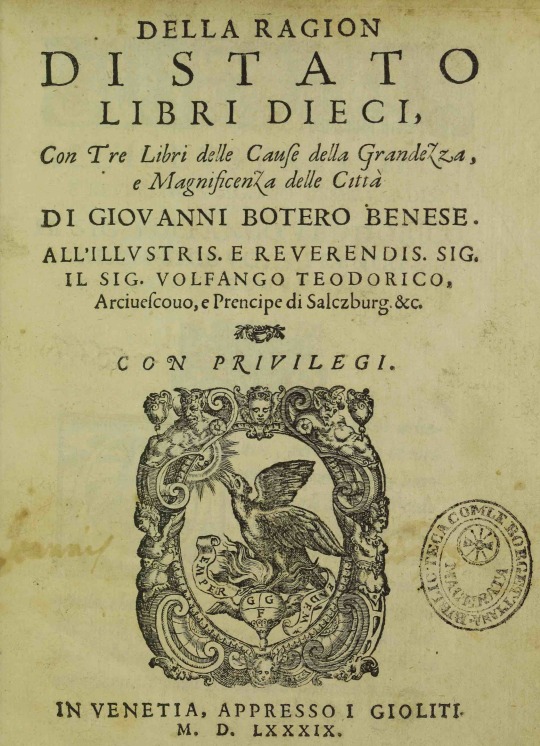
How do you build a grand and magnificent city?
There are a lot of cities all around the world — how do you make one grand and magnificent? What if Torino was magnificent and grand?
How would you make a small town in Piedmont magnificent and grand? What policy would you pursue? How could rulers take policy steps to achieve “grand magnificence”?
Clearly this seems like a utopian idea. Why would Torino ever be grand? This is what Torino looked like when Botero was writing about it.
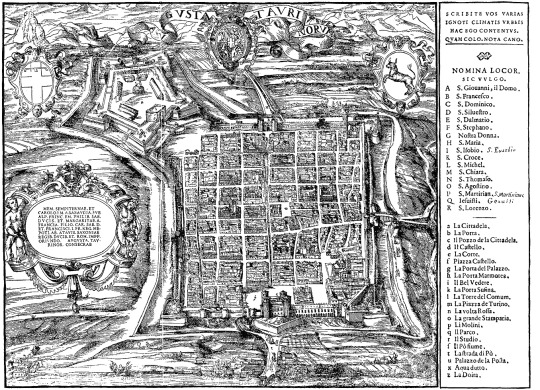
He is urging the Dukes of Savoy to make this little village magnificent and grand, but it’s not grand, it’s not magnificent. It’s just a small, typical Piedmontese town with a huge fort in the upper left-hand corner.
As Botero points out in his manifesto, no city in Piedmont has ever been grand. Torino is a modest city, like Asti, like Bra, like Cherasco. Botero himself is from Piedmont. He knows the history of the region. He is frank and honest about it, he’s a realist. There’s just never been a big city in Piedmont. No grand city like Genoa, Venice, Rome… This region of Italy had never had any grand magnificent town.
Why not? Well, Giovanni Botero is very keen on studying history, and geography, and law, and economics, and demographics, industrial policy and geopolitics, and other disciplines that did not have names in his own time. However, he somehow absorbed the political lesson of Utopia about how to imagine the town as a whole, functional place. How to get it to exist, how to get it to work.
Botero has learned to think in a utopian way that is realistic. He tells his readers that determined people can really do it. He doesn’t merely preach that Torino will somehow be grand. Instead, he says: what are the general principles of cities becoming grand?
This realistic map is Torino as a kind of Cherasco. It’s charming, in Cherasco. I’ve been to the historic town of Cherasco here in Piedmont, and it’s very nice, actually. I always enjoy it there in Cherasco.
Cherasco is the “world capital of snails.” If you’ve ever been to Cherasco, you would know the “Festa della Lumaca.” The Lumache… they’re great. They’re Slow Food, those snails. If you like “slow food” those snails are really, really slow.
It’s fabulous, I love them, and that is Torino without Giovanni Botero. Without the grand plans of Giovanno Botero, Torino is basically Cherasco.
Unfortunately I don’t have time here to discuss Botero’s ideas in detail, but I promise you, if you read his book, you will understand Torino much, much better.
He makes a very practical case for grandeur and magnificence. You don’t do it on a whim. There are political reasons to do it.
Botero says, to maintain a living city, you need three things. First, you need cheap bread. Not just bread, but enough that it’s cheap economically. Plenty to eat, always there.
Second, you need peace, because if the city is under siege all the time, and people are getting killed, and it’s some mere struggle for survival, that won’t allow the town to function. It just won’t be able to work.
Third, you need justice — so that the population doesn’t cut each other’s throats. There’s no civil war in the streets. People can get on with their productive business.
So, Botero says that peace, bread and justice are the basic necessities. But — they’re very difficult to maintain. Often, they will fail. Then the city will suffer a setback.
But — if the city is grand and magnificent — people will return. You will attract people with a spirited imagination who can appreciate the grandeur and the magnificence. That is the quality of urban people that you actually want. That’s why you do it.
So that was Botero’s realistic utopian plan. Unlike Thomas More, Botero did not get killed. He could have been killed, because life in the Ducal Court of Savoy was very dangerous, but he was allowed to retire with dignity here in Torino. When he died in Torino, he had the pleasure of seeing that indeed the town was becoming quite grand rather quickly.
So, that’s what a realistic Utopia can look like as a political success on an urban scale. The public utopia — but what about the private Utopia?
Botero shows us how to do it as a politician — and kind of get away with your grand plans — but what about our friend Raphael Hythlodaeus?
Raphael doesn’t want to do any public politics. He just wants to do as he himself pleases, every day. Does he also have a possible victory condition?
I actually think he does — the homemade private Utopia. Just one fellow. Like him. One wandering sailor with no great wealth and rather modest resources.
If he has determination, he can lead a surprisingly different life on private principles. Even in the 20th century.
So, this is the American artist Alexander Calder. A very inventive fellow. He spent a lot of time in Europe. Alexander Calder was a sailor for quite a while, much like Raphael Hythlodaeus. Kind of dressed in rags, not much money, a wandering dropout guy with one pair of shoes. A Paris bohemian artist who spent some time in Montparnasse.
In this picture, Alexander Calder decides to build his private Dream Home.

Out of this wreckage here. A big dead building.
Luckily he has Mrs Calder to help him, so he’s not completely alone. Mrs. Calder here — “Louisa James Calder” — she happens to be a cultured Boston aristocrat who speaks excellent French and has a lot of elite social contacts.

Her family said that she was “looking for a different way of life,” and when she married him, boy did she ever get one.
So here she is, making some French bread while Calder’s reading some art book. If you’re a design critic you would notice this is a very peculiar kitchen. Very peculiar indeed.
Here’s a photograph of his other house in France.

Calder probably made at least half the furniture in this room. His wife made the rugs. She was helping out, she liked to make carpets.

This is his studio. People said it looked like an airplane had crashed into the building. Calder had some unique personal filing system. He did not regard this as as a disturbed environment. This was his idea of efficiency. He was a very efficient and effective artist. He made 20,000 artworks in these studios over a 50-year career.
There are eyewitness accounts of him, grabbing his tools, grabbing pieces of stuff, and never misplacing anything. Nothing ever got lost in there. It’s otherworldly, very private, very weird and very personal.

This is a Calder handmade bread toaster. Why? Why would you need to make a personal toaster? You could just buy a toaster — and this one’s obviously dangerous. It’s not even made of industrial components — it’s made from scrap of no commercial value, made of bits of wood, leftover pieces of stone, and wire.
I’ve looked at it a lot. I’ve tried to figure out why Calder would do it. He built at least five of these. Five completely different self-invented unique toasters.
Why?
Why not just go buy the toaster at a store? Well — he very much wants to hand-make a toaster. He wants his toaster as a radically different toaster, the one that belongs to him. This is a “utopian device” in the sense of something that seems visionary, farfetched and silly.
It’s just not practical, not realistic — but it’s practical and realistic for him. Calder tended to make art out of objects that the world had abandoned. Like the Turinese “Arte Povera” method — find junk, and dress it up, and re-format it.
He had a different value system. To him this is is not junk. To him, this is a struggle for understanding.

Here he’s making forks. Why?
Why would anyone go to the trouble to make forks? Especially out of cheap wire, because these are wire forks that he hammered flat. So that wire would behave more like forks.
I think what happened here — Calder liked hand tools. People called him a machine artist, because he made sculptures that moved, and sometimes had motors. But he only had two machines in his studio — a drill and a grinder.
He had no other machines. He preferred making personal things with his hands. Expressive tools — in his own hands.
So he’s sitting and he’s eating with a fork — and he realizes this is a tool in my hand. This fork is a tool in my hand. Why isn’t it my personal fork? Why doesn’t this fork have more of my own values?
Right? It’s a Utopian Fork! It’s my personal very different Fork. I don’t care how long it takes me to make it. I want it to express! I want to hold it in my hand and eat with it.
It’s not for sale. These are not commodities. They are what they are — artifacts from a very different value system.
He was a successful artist — at the end of his life, very successful. Calder was quite a wealthy man, and after he died, then his heirs were very wealthy indeed — by artistic standards.
His home in France is an art center now. You can go there and make art in his studio.

These may not quite look like utopian objects, because they’re so personal. But it’s probably what a handmade personal Utopia actually has to look like. You have to dig down to the original basic principles.
It has the freedom of Raphael Hythlodaeus. It’s intelligent. It’s erudite. It’s well traveled, cosmopolitan. But the rules of the world do not apply to it. They just don’t. It’s “Utopia fai-da-te.” It’s a house as Utopia, it’s private, it’s homemade.
You could you do this yourself, personally, after you left the hall of the speech here. Great — I go back to the house, I make my own Fork. Right? You could, it’s not impossible. You could do it. He did it. He’s proving to himself that he can do it. It’s just — that it’s very rare.
Why? Why do you need a personal Utopia? Why does that matter to you? Where is the benefit? Why not just buy the same toaster that the guy has next door?
Raphael Hythlodaeus could go back to Portugal. He could get a job. He could get married. He could work for the Duke. The private Utopia — it’s like one man trying to to do everything that the world can do for him.
Also, Calder’s alone in the countryside. He’s not in the city. He doesn’t have any critics watching him, as he makes unrealistic forks.
What about the city, the public utopia, the City full of other people? What about — for instance — the Utopian city of Torino? The grand, magnificent Turinese realistic utopia?
What can be said about it, here and now?
Well, I have some passing ideas on that subject — mostly because I have read Giovanni Botero.
Botero wants to use grand magnificence to attract people into the town. His strategy is about a town that can survive. Not because it’s a town that is really good at snails, but because it is a grand city with glamour and charisma. That’s why why you want to do it.
Also, it’s pretty clear that to me that this — realistically — is what Torino has been doing for much of my lifetime. Torino was a city that suffered economic setbacks in the 1970s, and was having some basic Botero-style trouble with the food and the justice system and so forth.
But — when the heavy manufacturing failed — it has been slowly trending toward art, design and especially tourism. Heritage tourism. The Baroque architecture in Turin has not been this sexy in 300 years. Botero’s grandeur is an international tourist draw. It’s becoming like a Turinese Florence.
You might have to visit it over a long period to see this urban transformation, but it’s realistically happening. It doesn’t look or feel like a utopian project — because it’s basically about attracting tourists.
However, tourists have utopian aspects. Mostly because they’re struggling to escape from their real lives. They’re dying from too much realism — the harsh reality of their crushing lives. They want to experience something that feels different and refreshing, if only for two weeks.
A basic Turinese problem here is that Torino is progressive, but a heritage tourist industry, which is very attractive to tourists, has no avant-garde. Their stifling interest in your past holds you back. You can’t do “futuristic heritage industry.” Why? Because you can’t move forward into the past.
Supposedly.
Supposedly, you can’t show anybody any “new past.” You can only show them old, decayed remnants from the past that have always been here, and have somehow survived to the present day. You can’t show them an exciting, innovative past that no one has ever seen before.
However — if you wanted to be realistic and utopian — you might actually do this.
While Giovanni Botero was alive and writing about how to build Torino, this was Torino’s most grand and magnificent building.

Everybody in Torino knew this building. It was the Mole Antonelliana of medieval Turin. This is the “Tower of St Gregory,” the tallest tower in Turin.
Giovanni Botero saw this Tower every day. Everybody in Torino saw this Tower every day. If he was alive, among us in this room, he’d be horrified to realize it was gone. It would be a tragic loss. A Torino with no “Civic Tower”? A dystopian disaster! Scarcely a real Torino at all.
If the Civic Tower was still actually here, it would attract endless tourists. It happened to be demolished in the year 1801, because Napoleon knocked it down. There were efforts to rebuild it, but these efforts failed due to lack of economic realism.
However, if you did restore the Tower of Saint Gregory from utopian impulse, you could offer it to tourists as an exciting new heritage building. You could do that, because the city of Torino has excellent archives, and there are all kinds of records about exactly what this Tower looked like during the 500 years that it towered over Torino.
The Turinese are very skilled at restoring partially damaged buildings. They do that all the time. So why not just restore the entire building? Why not be bold and inventive, and utopian and realistic, and make a completely vanished building come back to life?
This grand and magnificent Tower has been gone since 1801, but now it’s back again. It was history, but now it exists again. It’s not illegal to restore vanished buildings. Physically, it wouldn’t even be that expensive to do it — certainly not by the standards of many other ambitious Turinese urban projects.
It’s mere custom, and the habit of mind, that makes you think that old buildings can’t suddenly spring back to life out of the records. Of course they can.
When I started this speech, I said that Raphael Hythlodaeus was a tourist. He went to see Utopia. He took a lot of notes. He never settled in Utopia. He never married a Utopian woman. He never emigrated to Utopia. He didn’t ask for Utopian citizenship.
He just witnessed Utopia and then he lectured about it.
But there is no “Utopia for tourists.”
If you’ve ever been a tourist, you know it’s actually a rather dystopian user experience. The experience is more or less horrible.
Maybe you want to go to another country — because you’re a tourist. You want to experience a different way of life. You want refreshment, you want escape from your reality.
Well, first you go to the airport — where you’re treated as a terrorist. They literally go through your luggage, your shoes.
Then you reach the border and there you’re treated as a clandestino, or maybe a smuggler. They’re extremely suspicious and hostile. Those are not even realistic efforts. They don’t really serve the cause of law enforcement or of civil order. They’re actually systems which are built for intimidation. They’re there to make you feel worse and to be sorry that you ever decided to travel. They’re in place to hurt your feelings and discourage you.
Then, as a tourist — when you’re a tourist in a foreign city — everyone hates you. Attempts are made to tell you to enjoy yourself, to eat the expensive food and spend your money on nice clothes, but there’s very little there that’s for your actual benefit.
That’s all just basically advertisements. That’s the business model. The local people want nothing you might offer as a human being, they simply want your cash. They don’t want you around. And for good reasons. When masses of tourists arrive in your city — when you’re a really successful tourist city — it’s like the city dies wherever they step.
There doesn’t seem to be any civilized way to deal with them. Even if you’re a tourist, you hate the other tourists.
These people — tourists — are the people within your city who realistically need a Utopia. You don’t need a Utopia. They need the Utopia.
If you’re a native of the city, you’re used to the city. You cherish the city. You’re a patriot. You want to live in the city with your memories, your urban experiences, that make it your place, your city.
You don’t want your City to be a Utopia — not even your own backyard! Here in Turin, if someone said, “Make the San Donato district a Utopia” — Everyone in San Donato would immediately say: “Make Campidoglio do it!”
“Make Cit Turin do it! Not us!” Then they would force San Salvario to become the Utopia, because San Salvario is full of foreigners and they never know what to say.
So if you want to build a utopia -- realistically -- you should build one for tourists.
I’m not sure what that would look like. I could speculate about it a little. I think it would be mostly psychological.
It would be like a a wellness retreat. Some kind of spa. I’m thinking some large Turinese building like a derelict factory. Empty — like the Cavallerizza. Or the former “OGR,” the dead train repair yard. Some derelict space turned into a big utopian box.
It should be soundproofed. It should be airtight — like a gambling casino, where no clocks are visible. There are no windows. The air should be filtered because the air in Torino is terrible. There are hundreds of tourists inside this utopian box. Maybe thousands of tourists in there.
It costs nothing to get into the box. It’s a free public amenity in Turin — built just for them, entirely for them.
But to get into this Utopia they have to remove their phones. They have to remove their clothing. They have no wallets, no purses, no purchasing power.
No money. No identity. No passports. They have to remove themselves, that’s the key to it. They’re free — free not to be who they are.
What’s in there? Nothing. There’s nothing to buy. There are no thrill rides, no multilingual experiences.
I think the tourists themselves should probably disappear. They should be wearing special effect suits, like this.

Special tourist holiday suits that cause people to vanish. They blend into whatever is projected on the walls. I think that projection is probably Torino — dream-like utopian images of Torino.
Not the realistic Torino, with Turinese people in it, but a tourist utopian Torino, grand, magnificent, unearthly — and there’s no plot. Nothing happens there. Nothing bothers you. Everything is under gentle surveillance. You’re a utopian tourist. You’re just peacefully drifting around through this foreign space, and you’re also foreign. You could sleep in there if you want.
Most tourists, they don’t really want thrills or excitement. They are tourists to escape the everyday trauma of their miserable lives. They’re not moving toward the attractions. They’re running away from their dystopian suffering. So they should be in a utopia, and they should vanish. Nobody has to look at them. They’re engrossed in Utopia. Eventually they come out then maybe they spend some money before they go back to their private lives elsewhere.
Okay, now I’ll close with a few personal words. I’ve spent a lot of time in Torino myself — sometimes on a tourist visa. But I have never once been “on vacation” in Torino.
Never. I never had a job here. I don’t labor here. I’m not a voter. I don’t participate politically. I don’t stare at the tourist attractions. I don’t even eat the tourist food.
For my wife and myself, Torino is our city of romance. We had known about one other for rather a long time, but Torino is where we first met.
It seemed utopian to think that we might ever be together. Because there were all kinds of good, sensible reasons why people from Texas and Serbia should never get married. For the two of us to be a husband and wife, it seemed farfetched and absurd, and yet, there was something realistic about it. Because it was Torino. We were really together there. It was true, it was real life.
A romance is a remote possibility — like mere wishful thinking, an empty dream — that can suddenly spring into real life. You can never plan for that to happen. But when it does happen, you become very aware of it.
It’s not that I went to Torino, or that she went to Torino — rather that we went to Torino. We do participate in the life of the city, but we’re just not Turinese. I can’t claim that we have any conventional purpose here at all. Nothing political, nothing economic, nothing diplomatic. Nothing that fits into a business plan or a government form.
Mostly we’re in Torino because in Torino we are us. In Torino we became us. A rather mysterious and utopian quality for a city to have. So Torino is not Utopia, but we do appreciate your kindness and your hospitality. So, thank you for that, and that concludes my speech.
Thank you for your attention.
136 notes
·
View notes
Text
No more future of humanity, huh? Guess I'll go fetch the potassium cyanide...

Well, so much for that.
156 notes
·
View notes
Text
Should have kept my projector...

*Every day someone bruisingly encouters the realities of "dead media"
5K notes
·
View notes
Text
Serious, timely






Unbelievable statistics about maternal death rates and poor outcomes for pregnant women of colour in the UK are highlighted in a new campaign for the women’s health charity Sister Circle, created by Droga5 London.
In fact, the statistics are so outlandish that Droga5 has decided to release the campaign on April Fool’s Day – the day traditionally devoted to bogus news.
In a series of OOH executions running across London, #NotAprilFools highlights that:
UK maternal death rates are the highest they’ve been in 20 years
1 in 4 mothers develop a mental health problem after pregnancy or childbirth – but they can wait up to 19 months to receive professional support
Black women are four times more likely to die in childbirth than white women
Women living in deprived areas are twice as likely to die in childbirth
Ocean Media and Jack London have donated space for the campaign at sites including Canary Wharf, Westfield, and Leicester Square. Thanks to Sister Circle’s network of influencers, the campaign will also appear on social media.
Sister Circle is led by women and is based in the London borough of Tower Hamlets. It supports women in challenging circumstances, offering a range of services, including support for new mothers, survivors of female genital cutting, and those who are escaping domestic abuse or trafficking.
Droga5 London, part of Accenture Song, was also behind Sister Circle’s rebrand last year. It had previously been known as Women’s Health & Family Services.
Karen Wint, CEO of Sister Circle, said: “We are so very grateful to the incredible Droga5 team for creating this important campaign #NotAprilFools. Women’s health has been hugely underfunded for so many years, and the impact of this on women’s lives can be seen through the creative approach. Our partnership is vital in helping us to increase awareness of the issues facing ethnic minority women and to advance our work by encouraging women to volunteer with us and raise those ever-important pounds to fund our work.”
Shelley Smoler, Chief Creative Officer of Droga5 London, said: “As huge advocates of our charity client, Sister Circle, our mission is to help them make these hard-hitting facts about women in the UK as bogus as the others that we’re confronted with on April Fools.”
3 notes
·
View notes
Photo
The moon thinking mars is tiny and it could totally take them on

Mars at the Moons Edge
Credits: Sergio Scauso
872 notes
·
View notes
Text
A tragedy is when two truths collide
1 note
·
View note
Text
Good questions to be asking (about 12 months ago...)
US National Priorities for Artificial Intelligence, please help
https://www.whitehouse.gov/wp-content/uploads/2023/05/OSTP-Request-for-Information-National-Priorities-for-Artificial-Intelligence.pdf
Request for Information National Priorities for Artificial Intelligence
AGENCY: Office of Science and Technology Policy (OSTP). ACTION: Notice of Request for Information.
[3270-F1]
SUMMARY: The Biden-Harris Administration is developing a National Artificial Intelligence (AI) Strategy that will chart a path for the United States to harness the benefits and mitigate the risks of AI. This strategy will build on the actions that the Federal Government has already taken to responsibly advance the development and use of AI. To inform this strategy, OSTP requests public comments to help update U.S. national priorities and future actions on AI.
DATES: Interested individuals and organizations are invited to submit comments by 5:00 p.m. ET on July 7, 2023.
ADDRESSES: Comments must be submitted via the Federal eRulemaking Portal at regulations.gov. However, if you require an accommodation or cannot otherwise submit your comments via regulations.gov, please contact the program contact person listed under FOR FURTHER INFORMATION CONTACT. OSTP will not accept comments by fax or by email, or comments submitted after the comment period closes. To ensure that OSTP does not receive duplicate copies, please submit your comments only once. Additionally, please include the Docket ID at the top of your comments.
Federal eRulemaking Portal: Go to www.regulations.gov to submit your comments electronically. Information on how to use www.regulations.gov, including instructions for accessing agency documents, submitting comments, and viewing the docket, is available on the site under “FAQ” (https://www.regulations.gov/faq).
Privacy Note: OSTP’s policy is to make all comments received from members of the public available for public viewing in their entirety on the Federal eRulemaking Portal at www.regulations.gov. Therefore, commenters should be careful to include in their comments only information that they wish to make publicly available. OSTP requests that no proprietary information, copyrighted information, or personally identifiable information be submitted in response to this Request for Information (RFI).
Instructions: Response to this RFI is voluntary. Each responding entity (individual or organization) is requested to submit only one response.
Responses may address one or more topics, as desired, from the enumerated list provided in this RFI. Responders should note the corresponding topic number(s) in their response. Submissions must not exceed 10 pages (exclusive of cover page and references) in 11-point or larger font. Responses should include the name of the person(s) or organization(s) filing the comment, as well as the respondent type (e.g., academic institution, advocacy group, professional society, community-based organization, industry, member of the public, government, other). Comments referencing materials that are not widely published should include copies or electronic links of the referenced materials. No business proprietary information, copyrighted information, or personally identifiable information (aside from that requested above) should be submitted in response to this RFI. Comments submitted in response to this RFI may be posted online or otherwise released publicly.
In accordance with Federal Acquisitions Regulations Systems 15.202(3), responses to this notice are not offers and cannot be accepted by the Federal Government to form a binding contract. Additionally, those submitting responses are solely responsible for all expenses associated with response preparation.
FOR FURTHER INFORMATION CONTACT: For additional information, please direct questions to Nik Marda at [email protected] or 202-456-6121.
SUPPLEMENTARY INFORMATION:
Background: AI has been part of American life for years, and it is one of the most powerful technologies of our generation. The pace of AI innovation is accelerating rapidly, which is creating new applications for AI across society. This presents extraordinary opportunities to improve the lives of the American people and solve some of the toughest global challenges. However, it also poses serious risks to democracy, the economy, national security, civil rights, and society at large. To fully harness the benefits of AI, the United States must mitigate AI’s risks.
The Biden-Harris Administration has already taken significant steps to advance responsible innovation, protect the American people’s rights and safety, and ensure all Americans benefit from AI. The Federal Government funds significant amounts of responsible research in AI, has issued an updated National AI R&D Strategic Plan, and developed a plan to build a National AI Research Resource to ensure that more researchers have access to tools to leverage AI. The Biden-Harris Administration has protected national security and maintained global competitiveness, including by banning exports to the People’s Republic of China of high-end computer chips used to build AI and by developing a strategy for responsible AI in defense. It has laid out a Blueprint for an AI Bill of Rights, an AI Risk Management Framework, provisions across multiple executive orders, and many actions across the Federal Government to promote responsible AI innovation, manage the risks associated with AI, and ensure AI systems are trustworthy and equitable. The Administration has also worked with like-minded partners around the world to assess AI’s implications for the workforce, to advance collaborative AI research and development, and to ensure technology works for democracy.
The Biden-Harris Administration is undertaking a process to ensure a cohesive and comprehensive approach to AI-related risks and opportunities. By developing a National AI Strategy, the Federal Government will provide a whole-of-society approach to AI. The strategy will pay particular attention to recent and projected advances in AI, to make sure that the United States is responsive to the latest opportunities and challenges posed by AI, as well as the global changes that will arrive in the coming years. Through this RFI, OSTP and its National AI Initiative Office seeks information about AI and associated actions related to AI that could inform the development of a National AI Strategy.
OSTP will also draw on public input from ongoing and recent RFIs, including:
OSTP’s RFI to the Update of the National Artificial Intelligence Research and
Development Strategic Plan;
The National Telecommunication and Information Administration’s Request for Comment on AI Accountability Policy;
OSTP’s and the National Science Foundation’s RFI on Implementing Initial Findings and Recommendations of the National Artificial Intelligence Research Resource Task Force;
OSTP’s RFI on Automated Worker Surveillance and Management; and
OSTP’s RFI on Public and Private Sector Uses of Biometric Technologies. If you have already responded to one or more of these RFIs, your prior input will be considered
in the context of developing the National AI Strategy.
Scope: OSTP invites input from any interested stakeholders. OSTP will consider each comment, whether it contains a personal narrative, experiences with AI systems, or technical legal, research, policy, or scientific materials, or other content that meets the instructions for submissions to this RFI.
Information Requested: Respondents may provide information for one or more of the questions listed below, as desired. Note that the list below does not cover some AI topics as completely, such as AI research and development, given ongoing or recent RFIs on those topics.
Protecting rights, safety, and national security:
What specific measures – such as standards, regulations, investments, and improved trust and safety practices – are needed to ensure that AI systems are designed, developed, and deployed in a manner that protects people’s rights and safety? Which specific entities should develop and implement these measures?
How can the principles and practices for identifying and mitigating risks from AI, as outlined in the Blueprint for an AI Bill of Rights and the AI Risk Management Framework, be leveraged most effectively to tackle harms posed by the development and use of specific types of AI systems, such as large language models?
Are there forms of voluntary or mandatory oversight of AI systems that would help mitigate risk? Can inspiration be drawn from analogous or instructive models of risk management in other sectors, such as laws and policies that promote oversight through registration, incentives, certification, or licensing?
What are the national security benefits associated with AI? What can be done to maximize those benefits?
How can AI, including large language models, be used to generate and maintain more secure software and hardware, including software code incorporating best practices in design, coding and post deployment vulnerabilities?
How can AI rapidly identify cyber vulnerabilities in existing critical infrastructure systems and accelerate addressing them?
What are the national security risks associated with AI? What can be done to mitigate these risks?
How does AI affect the United States’ commitment to cut greenhouse gases by 50-52% by 2030, and the Administration’s objective of net-zero greenhouse gas emissions no later than 2050? How does it affect other aspects of environmental quality?
Advancing equity and strengthening civil rights:
What are the opportunities for AI to enhance equity and how can these be fostered? For example, what are the potential benefits for AI in enabling broadened prosperity, expanding economic and educational opportunity, increasing access to services, and advancing civil rights?
What are the unique considerations for understanding the impacts of AI systems on underserved communities and particular groups, such as minors and people with disabilities? Are there additional considerations and safeguards that are important for preventing barriers to using these systems and protecting the rights and safety of these groups?
How can the United States work with international partners, including low- and middle- income countries, to ensure that AI advances democratic values and to ensure that potential harms from AI do not disproportionately fall on global populations that have been historically underserved?
What additional considerations or measures are needed to assure that AI mitigates algorithmic discrimination, advances equal opportunity, and promotes positive outcomes for all, especially when developed and used in specific domains (e.g., in health and human services, in hiring and employment practices, in transportation)?
How might existing laws and policies be updated to account for inequitable impacts from AI systems? For example, how might existing laws and policies be updated to account for the use of generative AI to create and disseminate non-consensual, sexualized content?
Bolstering democracy and civic participation:
How can AI be used to strengthen civic engagement and improve interactions between people and their government?
What are the key challenges posed to democracy by AI systems? How should the United States address the challenges that AI-generated content poses to the information ecosystem, education, electoral process, participatory policymaking, and other key aspects of democracy?
What steps can the United States take to ensure that all individuals are equipped to interact with AI systems in their professional, personal, and civic lives?
Promoting economic growth and good jobs:
What will the principal benefits of AI be for the people of the United States? How can the United States best capture the benefits of AI across the economy, in domains such as education, health, and transportation? How can AI be harnessed to improve consumer access to and reduce costs associated with products and services? How can AI be used to increase competition and lower barriers to entry across the economy?
How can the United States harness AI to improve the productivity and capabilities of American workers, while mitigating harmful impacts on workers?
What specific measures – such as sector-specific policies, standards, and regulations – are needed to promote innovation, economic growth, competition, job creation, and a beneficial integration of advanced AI systems into everyday life for all Americans? Which specific entities should develop and implement these measures?
What are potential harms and tradeoffs that might come from leveraging AI across the economy? How can the United States promote quality of jobs, protect workers, and prepare for labor market disruptions that might arise from the broader deployment of AI in the economy?
What are the global labor force implications of AI across economies, and what role can the United States play in ensuring workforce stability in other nations, including low- and middle-income countries?
What new job opportunities will AI create? What measures should be taken to strengthen the AI workforce, to ensure that Americans from all backgrounds and regions have opportunities to pursue careers in AI, and otherwise to prepare American workers for jobs augmented or affected by AI?
How can the United States ensure adequate competition in the marketplace for advanced AI systems?
Innovating in public services:
How can the Federal Government effectively and responsibly leverage AI to improve Federal services and missions? What are the highest priority and most cost-effective ways to do so?
How can Federal agencies use shared pools of resources, expertise, and lessons learned to better leverage AI in government?
How can the Federal Government work with the private sector to ensure that procured AI systems include protections to safeguard people’s rights and safety?
What unique opportunities and risks would be presented by integrating recent advances in generative AI into Federal Government services and operations?
What can state, Tribal, local, and territorial governments do to effectively and responsibly leverage AI to improve their public services, and what can the Federal Government do to support this work?
Additional input:
29. Do you have any other comments that you would like to provide to inform the National AI Strategy that are not covered by the questions above?
Dated: May 23, 2023 Stacy Murphy, Operations Manager.
215 notes
·
View notes





